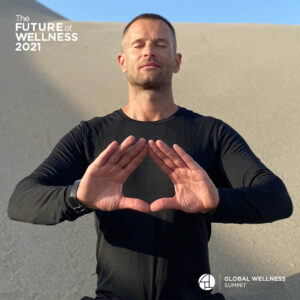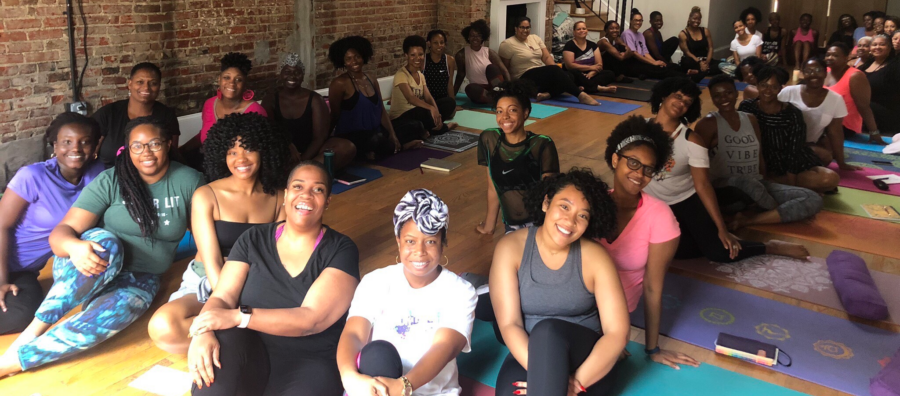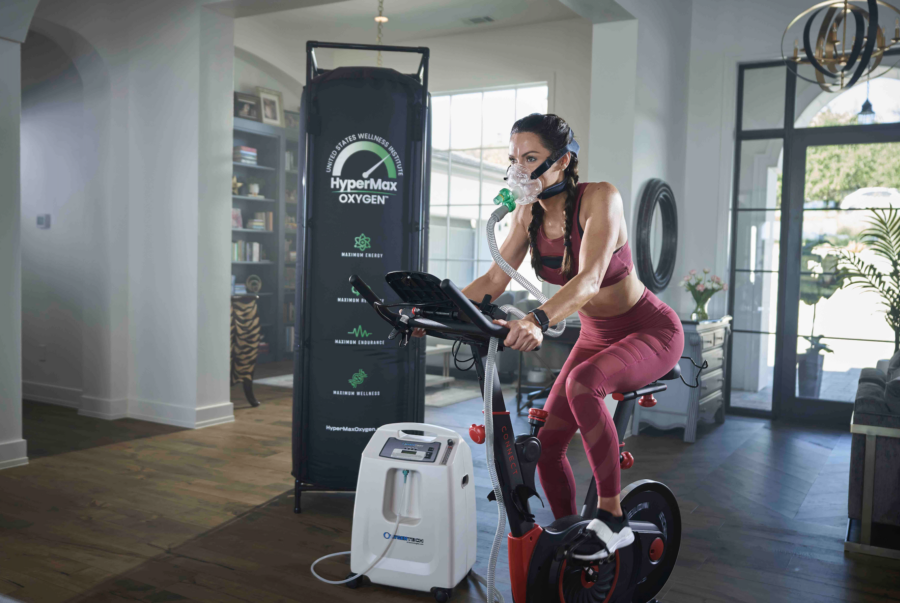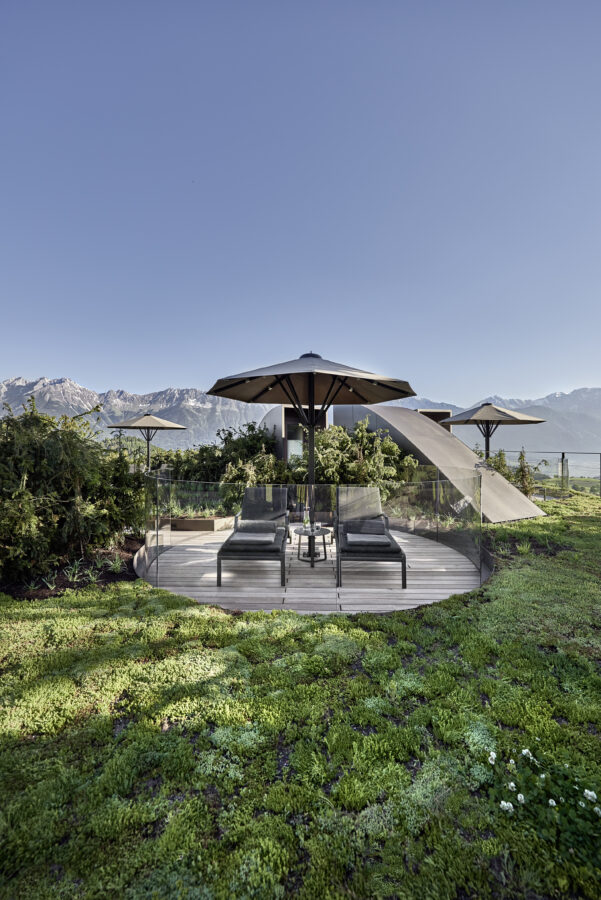
Trend #4
Just Breathe!
Breath goes from woo-woo wellness to a powerful health tool
By Sandra Ballentine
Download Trend
Introduction
Breathwork used to sit squarely on the woo-woo side of the wellness spectrum, but in recent years, clinical studies conducted at schools like Harvard, Stanford1, 2 and Johns Hopkins3 have put modern science and real data behind something we’ve actually known for centuries—the way we breathe has profound effects on our mental and physical health and abilities.4, 5
“I think a lot of people have ignored breathwork because it’s so simple and it’s free—it costs nothing,” says James Nestor, author of Breath: The New Science of a Lost Art (and a 2020 Global Wellness Summit keynote speaker). “But there is so much research out there, and so many people are discovering for themselves how transformative it is, that I think it will keep growing. I certainly hope so because we need it now more than ever.”
Breathwork may be simple, but it can seem daunting to the uninitiated. While it’s true that elite athletes, adventurers and soldiers harness their breath to achieve seemingly impossible things and beat incredible odds, the beauty of breathwork is that it’s something all of us can access. Even the simple act of reciting a Shakespearean sonnet can put you in a therapeutic zone, according to Dan Brulé, a pioneer in the spiritual breathing movement.
“Reading certain poems and prayers out loud slows your breathing to somewhere between four and eight breaths per minute, which lowers blood pressure and decreases cortisol levels,” says Brulé. “Breathwork training is very powerful for high-stakes situations where lives can be lost, but all the amazing abilities of the warriors and the gurus and the yogis and the masters and the saints—well, the average person can access those very same high states and extraordinary abilities just by breathing.”
What follows is a curated compendium of the people, places, techniques and tech developments pushing the practical magic of breathwork into exciting—and important—new directions.
The People
The Iceman
Wim Hof is a Dutch extreme athlete, adventurer, daredevil and researcher known for his ability to withstand extreme cold and strengthen his immune system using a combination of breathing, mindset and cold therapy. Hof, who recently penned The Wim Hof Method: Activate Your Full Human Potential, has devotees around the globe. “The breath is very able to effectively bring anxiety down, as well as fight acute stress of any kind, including bacterial and virus stress and inflammation,” he says. “It’s scientifically endorsed, and it’s the future of natural control within humanity.” (@iceman_hof)
The Breath Biohacker
Dutch human optimization specialist (and sometimes Wim Hof instructor) Kasper van der Muelen takes a synergistic approach to breathwork, striving to “connect the dots between ancient practice, modern science, human performance, personal healing and expanding consciousness.” As if that weren’t enough, he claims to have used focused breathwork to heal his broken arm. The author of Mindlift: Mental Fitness for the Modern Mind (published in 2016), van der Muelen teaches an intense five-week Breathwork Masterclass in Utrecht, the Netherlands, that’s a magnet for, well, intense biohackers.
The Godfather
A leading expert in breathing behavior analysis (and breath trainer to global special forces), behavioral physiologist Dr. Peter Litchfield6 has been on the vanguard of breathing science for nearly 40 years. Specializing in the causes of dysfunctional breathing and solutions that help combat it, Litchfield is forging a new physiological learning model by combining the behavioral sciences with respiratory physiology. In 2001, he invented the CapnoTrainer, a game-changing educational capnography7 device and cutting-edge software program designed to help people identify their breathing habits and learn how to replace dysfunctional ones with adaptive, self-sustaining ones.
The Breathvangelist
Make it fun, and they will come. If anyone can bring modern breathwork to the masses (in a safe, supportive way), it’s breath artist Sage Rader, whose rock-star delivery alchemizes science and spirituality into entertainment. Rader, who credits breathwork with saving his life and helping him manage devastating chronic pain after an accident, uses a combination of breathing, brain games and music to achieve rapid, deep shifts in consciousness and physical relaxation. He “breathes” private clients (major celebs, tech founders and CEOs who he calls his “super babies”) and is the founder of Breath Church, a (currently virtual) haven for rest, regeneration and relationship-building. “People who breathe together consciously over time begin to share a common bond that transcends words or rational explanation,” he says. “It is a sense of embodied belonging.”
The Community Builder
Motivated by what she saw as a lack of minorities in the breathwork space, Atlanta-based entrepreneur and innovator Jasmine Marie founded Black Girls Breathing in 2018 to provide consistent mental healthcare services to her community, which faces specific mental and emotional health challenges. “I wanted to bring the accessible tool of breath to Black women to help them relieve chronic stress, which too often can lead to disease,” she says. Marie launched a crowdfunding mission last year in the wake of George Floyd’s killing and the subsequent Black Lives Matter protests that will give 150+ Black women per session free entry to virtual breathwork circles in perpetuity.
The Spiritual Technologist
For her Blisspoint Breathwork method, digital nomad Lisa de Narváez curates clubby soundscapes embedded with special, customized frequencies that help people connect with their breath, open their heart, and drop into a state of altered consciousness. De Narvaez’s international followers usually line up for Blisspoint at festivals and wellness events, but since lockdown, they’ve been logging in to her virtual events. “I have been blown away by how deeply and powerfully this work translates through technology,” she says. “It has given us access to tapping into unified fields during these times of uncertainty, literally showing us that we are truly one.” (@blisspoint.co)
The Wild One
In a town with a LOT of breathworkers, Los Angeles-based Estonian native Johann Urb stands out. His super-trendy Pyramid Breath Method is more somatic than most, combining sound-release therapy (think primal screams, guttural growls and everything in between), movement and visualization to cathartic effect. “It’s a pretty wild ride,” says Urb.
The Recovery and Integration Expert
Erin Bishop, a breathwork practitioner and integration coach who splits her time between Maryland and Washington, helps people manage chronic pain, addiction and trauma response by using their breath. She sees clients one-on-one and instructs them how to pair diaphragmatic breathing (deep belly breathing) with spiritual, or conscious-connected, breathing. “I teach you the fundamentals of how to breathe to manage your emotions and regulate your nervous system,” she says. “Then we slowly start to bring in the Eastern side, the spiritual side, and go into conscious-connected breath because, from a cellular perspective, that’s the technique that drives the kind of forbidden, hidden experiences and messages you’ve been trying to bury all your life and brings them to the surface so you can finally start to attend to them.” Many of her clients have experienced sexual or physical abuse, so Bishop eschews aggressive therapy techniques like holotropic, or rapid, breathing for a more gentle approach. “People nowadays—especially in view of the Me Too movement—are using their voices in a way that they didn’t have permission to before,” she says. “So, talking through and integrating their experiences is something they really need.”
The Youth Advocates
What if just five minutes of slow breathing could significantly reduce adolescent and teen stress and anxiety? Brian Mackenzie8 and Tanya Bentley, PhD, the co-founders of the Health and Human Performance Foundation (HHPF), are raising funds for research supporting Breathe for Teens, a scalable, HHPF-designed school curriculum that uses slow breathing to help kids cope with anxiety. “We want to teach them how to breathe so they can start managing stress like their parents did not learn how to do,” says Mackenzie, an elite performance and breathing expert. “Not only do the kids need this, but the parents and teachers need this,” he says, adding, “Mental health issues will no doubt be one of the biggest challenges people of all ages will face in the next four or five years.”9
The Regeneration Specialist
“In my opinion, breath is the underlayer of all movement,” says Jill Miller,10 the co-founder of Tune-Up Fitness Worldwide and creator of Yoga Tune Up and the Roll Model Method, a self-massage technique. Miller, whose book Body by Breath comes out later this year, was an early adopter of self-myofascial release and teaches clinical professionals techniques she developed to work with the muscles of respiration and their fascial connections throughout the body using a soft, air-filled ball called the Corgeous. “There are so many regenerative applications for this work,” she says. “We have people using it for post-COVID recovery and post-cancer rehabilitation, as well as with athletes from the Cavaliers and the Dodgers.” Miller adds, “It’s like, how can I help people locate their own inner medicine chest by using tools, positions and practices that can lower their medical bills and take their health back—away from their pulmonologist, cardiologist and allergist—all the things that spiral into breath pathology.”
The Workout—The Future of Respiratory Fitness?
According to elite performance coach Owen Monroy, you don’t have to be an Olympian to benefit from intermittent hypoxic training (commonly known as oxygen training). Monroy heads up product development for HyperMax Oxygen, a consumer-focused fitness machine that works in tandem with most forms of indoor cardio (spin bike, treadmill, etc.) and combines altitude simulation with oxygen replenishment. Wearing a mask connected to a cylinder filled with high-test oxygen, users exert themselves at various altitudes and intensity levels, and when ready for a refresh, can push a button that changes their environment to four times its normal level of oxygen. “In 15 minutes, you get a low-impact workout that allows you to challenge and recover at an accelerated rate, and this applies to elite athletes or people working on rehabilitation or health journeys,” says Monroy, who adds that benefits can include better energy, increased circulation, improved nutrient delivery and reduced inflammation. “We’ve had particularly encouraging results with concussion recovery,” he says. “And numerous studies indicate that improving your VO2 max, or ventilatory maximum, can lead to increased longevity.”
The Techniques
Calculate Your Breathing IQ
Dr. Belisa Vranich, a clinical psychologist who specializes in breath (she recently co-wrote Breathing for Warriors: Master Your Breath to Unlock More Strength, Greater Endurance, Sharper Precision, Faster Recovery, and an Unshakable Inner Game), devised a functional test that can help you figure out if you are breathing “intelligently.” The “BIQ” test can be found on her website, along with primers for COVID-fighting lung-strengthening exercises and access to classes like Warrior Workshop (focusing on strength and endurance) and Breathing for Tactical Fitness, which is geared to first responders.
The Nose Knows
Mouth-breathers beware. If there’s one thing everyone in this report agrees on, it’s the importance of nose breathing. Most of us have heard of the gut microbiome by now, but did you know your nose has a microbiome, too? And it’s the first line of defense for your immune system. The air you breathe in through your nose is filtered by hair and mucus, which help combat bacterias and viruses—obviously, this is more important now than ever.
Time to Breathe…Tips from the Experts
Entrepreneur Sandy Abrams, author of Breathe to Succeed: Increase Workplace Productivity, Creativity, and Clarity Through the Power of Mindfulness, shares an easy relaxation technique.
“The general rule of thumb for tapping into the parasympathetic nervous system—the part of your nervous system that helps you relax—is to lengthen your exhales. If you make your exhale at least one and a half to two times as long as the inhale, your body begins to connect to that ‘rest and digest’ system as opposed to the ‘fight or flight’ mode that we tend to stay in during times of stress. Instructions: Close your eyes, sit up nice and tall, shoulders up and back, and take an inhale through your nose (when you inhale through your nose you connect to a part of your brain that regulates emotion) to a count of four, exhale slowly (through nose or mouth—whichever feels best) to a count of six to eight. Repeat for about a minute or two, and then repeat often throughout the day to feel more calm and grounded.”
Author and science reporter James Nestor practices what he preaches!
“People think that since I wrote a book about this stuff that I’m now the best breather in the world, that I’m, you know, wearing robes and practicing this craft every day, and I’m not at all. But I did pick up a lot of tricks along the way. I’m aware of my breathing all day long, and that is by far the most important thing. Once you become aware of it, you can really focus it, especially when working out. It’s amazing the difference it’s made adapting healthy breathing habits both while working out and sitting in my office. I do a vigorous practice—Pranayama, Sudarshan, Kriya, Tummo, Wim Hof, whatever you want to call it—about three times a week. The rest of the time, I’m breathing through my nose; I’m breathing slowly. I’ll practice the six seconds in, six seconds out as often as I remember. When I’m feeling stressed, I extend my exhales. When you extend your exhales, you calm your body. You decrease blood pressure, slow your heart rate, and if you don’t believe me, place your hand over your heart. Breathe in to a count of about three and exhale to a count of about six. Every time you exhale, you’ll feel your heart slowing down. You can use that little part of your breathing tool kit at any time throughout the day to calm yourself.”
Sometimes we all need a really good sigh, says applied spiritual breathwork maven Dan Brulé.
“A sigh is an inhale that is twice as big as normal, and that extra stretch, that extra expansion, is what triggers what we experience as a “sigh of relief.” It’s a natural response to a change in state; maybe it’s from pain to no pain or panic to no panic. We discovered in the military in the early ‘70s that when you’re in a state of pain or fear, and you give yourself a sigh of relief ahead of time, tension, pain and anxiety leave your body. Studies have shown that the average adult automatically sighs around 12 times an hour because if we don’t hyperinflate our alveoli every five minutes or so, we lose our respiratory capacity. Everyone has had the experience where, all of a sudden, you just took a big breath, and it came all by itself; it was totally relaxed, totally easy, and felt really good. My philosophy is hey, if nature makes us do it, why not double down and give yourself another sigh of relief right away and exaggerate it even more. Turn this natural response into a powerful, conscious breathwork technique. That’s as simple as it gets. Just start with a sigh of relief, and exaggerate it, play with it, squeeze all the juice and the pleasure out of it that you can, and you’re in the game; you’re biohacking.”
 The Places
The Places
The Breathwork Party
Right before lockdown, Donovan McGrath, the creator of Amplified Yoga, one of L.A.’s hottest live music-driven fitness classes, was poised to introduce Amplified Ecstatic Breath, a breathwork session/social hour, complete with mood-shifting colored lights, refreshments and a live DJ. When IRL classes are a thing again, “You’ll be able to come with friends or come alone and meet new ones,” says McGrath. “We’ll do a bit of gentle movement to some vibe-y, house-type electronic beats, and then lie down for breathwork. After the breath session, participants can share their thoughts with the group, and stick around for music, dancing, meditating and mingling. “All the good feels of a great party, but in a way that supports your health,” says McGrath. (@amplifiedyoga)
(Serious) Breathwork Festivals
The Breathing Festival (organized by Dan Brulé) will go virtual in February 2021 and will feature 52 leaders in the field. This summer’s Global Inspiration Conference in Sweden will hopefully be held in person.
Hospitality Takes a Breath
Responding to increased interest among guests, large and small hotels alike are adding breathing-related services and coaching to their spa and wellness menus. Some of the best places in which to inhale:
The Lanserhof health resorts in Austria and Germany have offered breathwork coaching for years and continue to enhance and update their respiratory offerings. The resort’s new Post-COVID Programme incorporates therapeutic breathing exercises.
The Six Senses Hotels, Resorts and Spas group hosts visiting breathwork practitioners at various properties and has featured breathwork tutorials in its At Home with Six Senses video series.
Cal-A-Vie Health Spa in Vista, California, offers private sessions of “Peaceful Breath and Rejuvenation” and “Breathe, Flow, Restore,” which teaches Pranayama breathing techniques.
In Mexico: Guests at Chablé Yucatan and Chablé Maroma often start their day with a 60-minute Energetic Breathing Practice, while in Tulum, breathwork offerings can be found at Habitas and Nomade.
In addition to collaborations with corporations and festivals, the London-based breathwork studio Breathpod brings breathwork seminars and pop-ups to hotels like Landmark Mandarin Oriental Hong Kong, Blakes London and Birch (a country hotel in Hertfordshire).
Miraval Arizona’s popular Breathwalking meditation involves synchronizing your steps to two different breathing techniques, the “Wave” and the “Stairs,” while hiking in nature. Guests who book Miraval Austin’s Pranayama-Dina experience are swaddled in a weighted blanket and suspended in a silk sling while a “guide” leads them in breathwork and massages them from below using a foot technique.
The rustic Troutbeck in Amenia, New York, just opened The Barns, a bijoux wellness center that offers private yoga and breath coaching.
Shou Sugi Ban House, a chic, wabi-sabi-inspired wellness hotel in East Hampton, New York, offers dedicated breathwork sessions like “Body Awakening and Breathwork” and “Breathwork Journey.”
Sangha Retreat by Octave Institute in Suzhou, China, offers breathwork training in various wellness programs.
The Tech
Breathwork apps and YouTube videos have been a thing for a while. Gaining traction are handheld devices that track air quality and fitness trackers and other wearables that incorporate breathing-related metrics like breathing rate, pulse oximetry, heart-rate variability and habitual breathing patterns. Some interesting examples include:
HeartMath and Lief use wearable sensors to help users track and increase their heart-rate variability, which is said to reduce stress.
Israel-based start-up Anicca is in the testing stage of its patent-pending Companion device, which aids in regulating the wearer’s emotions by amplifying the sensation of their breathing as a calming vibration on their body.
Another device developed in Israel, CalmiGo, helps users regulate breathing to reduce anxiety.
Muse 2 Brain Sensing headband incorporates breath metrics to aid in meditation.
Aimed at athletes, military personnel and first responders, RTM Vital Signs is developing a watch-like RTM R3 fitness monitor that can measure an ambulatory person’s respiratory rate (RR) and tidal volume (TV), body temperature, hemoglobin oxygen saturation, activity level and body position.
While not wearable, Field, a multimedia, AI-driven, “life transformation” experience that takes place in a cocoon-like pod, incorporates breathwork into its brain-training protocols.
Summary
With our basic ability to breathe and the safety of the air we inhale taking on even more significance since the onset of COVID-19, the world is collectively focused on breath. But even when the virus recedes, breathwork and breathing science will continue to gather momentum, and thanks to innovators in the sphere, reach ever-larger audiences. A drug-free way to achieve clarity and calm that can also help us fight things like depression, anxiety, hypertension and chronic pain? Let’s just say, I’ll breathe to that.
Endnotes
1 Bruce Goldman, “Study shows how slow breathing induces tranquility,” Standford Medicine, March 30, 2017, https://med.stanford.edu/news/all-news/2017/03/study-discovers-how-slow-breathing-induces-tranquility.html.
2 “What yogis know,” Standford Medicine, Summer 2017, https://stanmed.stanford.edu/2017summer/upfront/how-slow-breathing-induces-calm-lowers-stress.html.
3 “Psykia Institute and Johns Hopkins School of Medicine to Study Breathwork as Treatment for PTSD,” Psykia Institute, 2020, https://www.psykia.org/jhu-breathwork-research.
4 Michael R. Goldstein, Rivian K. Lewin, and John J. B. Allen, “Improvements in well-being and cardiac metrics of stress following a yogic breathing workshop: Randomized controlled trial with active comparison,” Journal of American College Health (2020) DOI: 10.1080/07448481.2020.1781867.
5 Pierre Philippot, Gaëtane Chapelle, and Sylvie Blairy, “Respiratory feedback in the generation of emotion,” Cognition and Emotion, 16:5, (2002) 605-627, DOI: 10.1080/02699930143000392.
6 Peter M. Litchfield, “Breathing: alignment of mechanics with chemistry,” IBF Newsletter, June 2017.
7 J. S. Gravenstein, M. B. Jaffe, N. Gravenstein, & D. A. Paulus, Capnography (New York: Cambridge University Press, 2011).
8 TGK Bentley, R. Wilson, B. MacKenzie, and S. Russell, “Anxiety, CO2 tolerance, and breath practice in high school students: feasibility and observations from a 6-week slow breathing program,” International Congress on Integrative Medicine and Health, May 2020, https://static1.squarespace.com/static/5bf8b5c6297114fff40f5fc4/t/5edace57d164975b782d560e/1591397982242/Bentley_ICIMH_2020.pdf.
9 Emma M. Seppälä, et al., “Promoting Mental Health and Psychological Thriving in University Students: A Randomized Controlled Trial of Three Well-Being Interventions,” Frontiers in Psychiatry, July 15, 2020, https://doi.org/10.3389/fpsyt.2020.00590.
10 Jill Miller, “The Immune Response and Deep Breathing,” Tune Up Fitness (blog), October 3, 2014, https://www.tuneupfitness.com/blog/the-immune-response-and-deep-breathing/.
Download this 2021 trend and receive the 2021 mid-year update as well. The 2022 Future of Wellness global trends report is now available. View the latest trends. Subscribe to our mailing list and receive the bi-weekly TRENDium, a compendium of the trends impacting the multi-trillion dollar global wellness economy featuring the latest news and insights. Sign-up to receive the TRENDium.